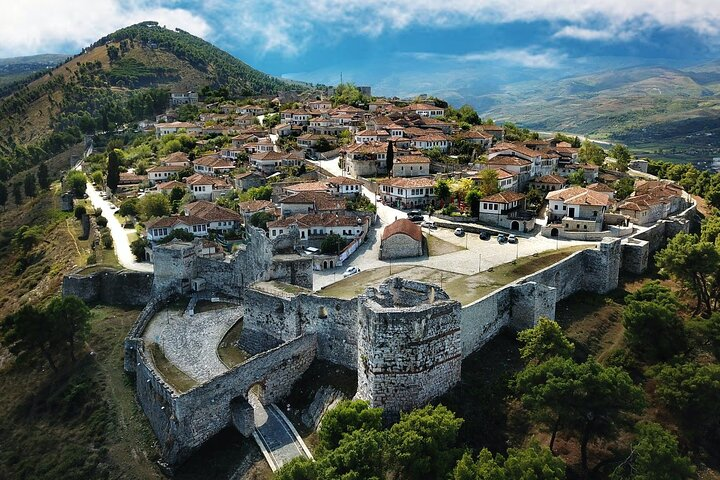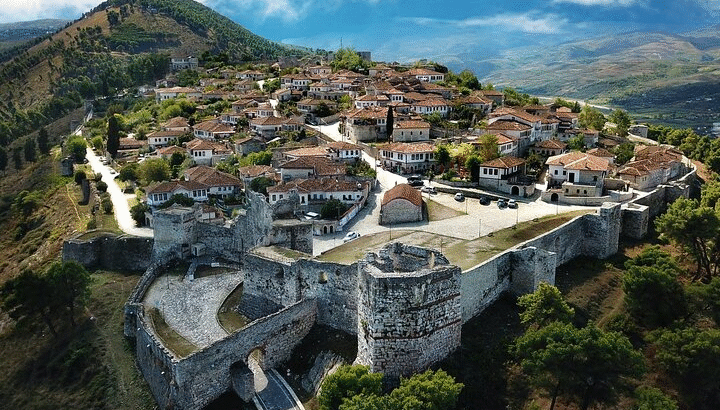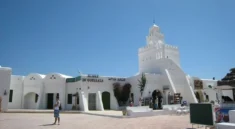
In a world where travel often means long queues, crowded streets, and camera-flashing hordes, some places still feel like whispers of history, echoing quietly through cobblestone alleys and timeworn walls. One such gem lies tucked into the hills of southern Albania: Gjirokastër, a UNESCO World Heritage Site that feels untouched by the rush of modern tourism. Built entirely of stone and crowned by a sprawling fortress, Gjirokastër is a living museum of Ottoman architecture, layered histories, and rich Balkan culture—with fewer tourists than any of Europe’s better-known historic cities.
Here, time slows as you wander through narrow stone lanes, admire traditional tower houses with sweeping wooden balconies, and gaze out over valleys that seem to stretch forever. It’s a place for travelers, not tourists—a destination for those who crave authenticity, depth, and discovery.
A Fortress Town Frozen in Time
Perched on a hillside overlooking the Drino Valley, Gjirokastër immediately stuns visitors with its dramatic layout. The entire town seems carved from the mountain itself, its stone buildings rising in tiers as if stacked upon one another. Above it all stands the Gjirokastër Fortress, a massive citadel that has watched over the town for centuries.
The fortress is more than a backdrop—it’s a gateway to the past. Walking through its arched entrance, you enter a world of cannons, crumbling watchtowers, and panoramic views of the valley below. Originally built in the 12th century and expanded under Ottoman rule, the castle now houses the National Armaments Museum, which includes everything from antique firearms to a U.S. military plane captured during the Cold War.
From the ramparts, the entire town reveals itself in one breathtaking panorama: gray slate rooftops, stone houses, and minarets rising amid cypress trees. The view alone is worth the climb.
Stone Upon Stone: The Unique Architecture Of Gjirokastër
What makes Gjirokastër truly special is its distinctive architecture. Known as the “City of Stone,” nearly every structure here is built from locally quarried limestone. The homes, or kullas, are fortified tower houses, a blend of residential and defensive architecture characteristic of the Ottoman Balkans.
Wander through the Old Bazaar, and you’ll be surrounded by centuries-old stone buildings adorned with wooden eaves and hand-carved balconies. These houses were designed not just for beauty, but for protection, with thick walls, narrow doors, and elevated living quarters.
Among the most iconic is the Zekate House, a three-story tower dating back to the early 19th century. With frescoed ceilings, Ottoman-style sofas, and views across the valley, it offers a glimpse into the domestic elegance of Gjirokastër’s wealthier past.
The Skenduli House is another must-visit—its labyrinth of rooms, secret passageways, and original features (like a Turkish bath and baby-feeding niches) make it a favorite for architecture enthusiasts.
These homes are more than tourist attractions—they’re living cultural artifacts, lovingly preserved by families and the community.
A UNESCO Site With Soul—Not Souvenirs
Gjirokastër was designated a UNESCO World Heritage Site in 2005, not just for its architecture, but for the way it has preserved a way of life that has largely vanished in much of Europe. Yet, despite its prestigious status, Gjirokastër has avoided the over-commercialization that often plagues similar sites.
There are no crowds, no chain stores, no forced entertainment. Instead, you’ll find elderly locals sipping coffee under fig trees, artisans weaving rugs or carving wood by hand, and children playing in alleyways where cars rarely go.
Souvenir shops, if they exist, are humble and authentic—selling locally made wool socks, copperware, olive oil, and carved wooden miniatures of the very houses you see around you. The town’s rhythm is unhurried, its hospitality genuine, and its cultural richness utterly immersive.
Layers of History and Culture
Gjirokastër’s story is not singular. It has been shaped by Illyrians, Byzantines, Ottomans, and modern Albanians. Each era has left its imprint, making the town a mosaic of influences and identities.
The Ottoman period gave the town its current shape, but beneath the streets and within the fortress lie Roman and Byzantine ruins, waiting for the curious traveler to uncover.
Gjirokastër is also the birthplace of Enver Hoxha, Albania’s infamous communist dictator. His former home now serves as the Ethnographic Museum, showcasing traditional life rather than glorifying the regime—an intentional decision that speaks to Albania’s evolving relationship with its recent history.
The nearby Cold War-era underground bunker, built to house the communist elite during a potential nuclear attack, adds another layer of contrast: a grim concrete maze beneath a town of grace and charm.
Cultural Events And Local Traditions
Despite its size, Gjirokastër punches far above its weight culturally. Every five years, it hosts the National Folklore Festival, a spectacular gathering of musicians, dancers, and performers from across Albania and its diaspora. Held in the fortress amphitheater, the festival is a celebration of Albanian identity and diversity, bringing together northern and southern styles, costumes, instruments, and dialects.
Music here leans heavily on polyphonic singing, a haunting, UNESCO-listed tradition in which multiple vocal lines intertwine. You might catch a spontaneous performance in a village tavern or during a local celebration.
Food, too, is central to the culture. Restaurants serve slow-cooked lamb, baked cheese pies (byrek), eggplant stews, and fresh mountain herbs. Hospitality is deeply rooted—expect free coffee refills, impromptu toasts, and recipes passed down through generations.
Nature At The Doorstep
Though the town itself is a highlight, Gjirokastër is surrounded by natural beauty that rivals its architectural charm. Towering above is the Gjerë Mountain, offering excellent hiking and birdwatching. In the valleys below, orchards and olive groves stretch toward the horizon.
A short drive away lies the Blue Eye (Syri i Kaltër), a surreal natural spring where turquoise water bubbles up from unknown depths, surrounded by dense forest. Nearby, the Viroi Lake offers a peaceful picnic spot or a chance for reflection after a morning of exploration.
The area is also close to Butrint, another UNESCO site and one of the Balkans’ most important archaeological parks—perfect for a day trip through ancient Greek and Roman ruins, coastal lagoons, and marshlands filled with birdlife.
Why Gjirokastër Remains Off The Beaten Path
So why isn’t everyone here? Part of the reason is geography. Albania, despite its stunning coastline and growing reputation, is still relatively new to global tourism. Gjirokastër, in the country’s south, is often overshadowed by Tirana or beach towns like Sarandë.
Infrastructure, though improving, can still be challenging. Roads are winding, signage can be confusing, and English is less commonly spoken outside tourist hubs. But these “inconveniences” are also what keep the experience real.
Here, you’re not just checking off sights. You’re having conversations, navigating organically, discovering as you go. There are no tour buses, no photo-op lines. Just the joy of genuine wandering.
Staying Awhile: From Guesthouses To Heritage Hotels
One of the best parts of Gjirokastër is the opportunity to stay in traditional homes that have been converted into guesthouses. These family-run accommodations offer intimate insight into local life. You’ll sleep under handwoven blankets, wake to views of the fortress, and dine on meals made with ingredients from the garden.
There are also boutique heritage hotels like Hotel Kalemi or Hotel Gjirokastra, which strike a balance between authenticity and comfort, often decorated with Ottoman-style furniture and traditional motifs.
You won’t find international chains or mass-market tourism here. What you’ll find instead is something much rarer: travel that feels personal, meaningful, and grounded.
Leaving With More Than Photos
As you prepare to leave Gjirokastër, don’t be surprised if you feel a quiet resistance. Many travelers report a strange pull—the desire to linger just one more day, to walk those cobbled streets again at sunset, to hear the echo of a shepherd’s call across the hills.
You may arrive curious, but you’ll leave reflective. This isn’t just a town to visit; it’s a town that reawakens how you travel. It reminds you that not every beautiful place is famous, and not every profound journey is loud.
Conclusion: Europe’s Quiet Gem, Waiting To Be Discovered
Gjirokastër may not have the name recognition of Prague, Dubrovnik, or Granada—but that’s its magic. It’s not trying to be anyone else. It’s a place that honors its past, invites you into its present, and leaves an imprint on your future.
So, if you’re searching for a destination where history whispers through stone, where fortresses stand tall above misty valleys, and where travel still feels like exploration, then wander into Gjirokastër—Europe’s best-kept secret, built from stone, soul, and silence.




